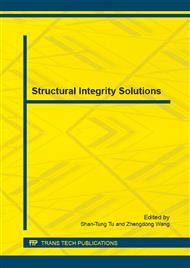p.51
p.59
p.69
p.76
p.79
p.89
p.96
p.104
p.114
The Strain-Based Failure Assessment Diagram for Commercially Pure Titanium TA2
Abstract:
Strain-based failure assessment methods have been usually used in recent years to propose the fitness-for-service flaws. In this paper, the stress-based and strain-based failure assessment diagram (SB-FAD) approaches were reviewed firstly. Then, SB-FAD approach was used to the material commercially pure titanium TA2 with high strain-hardening coefficient. Several failure assessment curves obtained from strain-based method for four typical specimens, i.e., CCP (center-cracked plate), DECP (double edge cracked plate), SECP (single edge cracked plate) and CT (compact tension) were proposed. It was found that the geometries and crack sizes had obvious effects on the failure assessment curves. By comparing with the stress-based failure assessment curves, the traditional strain-based failure assessment curves could lead to more conservatism in the stage after yielding. However, the SB-FAD modified by Ainsworth can be used.
Info:
Periodical:
Pages:
79-86
Citation:
Online since:
April 2015
Authors:
Price:
Сopyright:
© 2015 Trans Tech Publications Ltd. All Rights Reserved
Share:
Citation:


